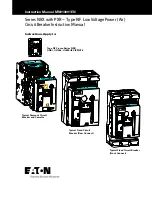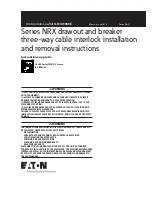
www.weg.net
WEG Molded Case Circuit Breakers - User’s Manual
3
The UBW225 circuit breakers (Figure 1) are rated from 15 A to 225 A continuous
current thermal-magnetic circuit breakers. Circuit breakers are listed in accordance
with Underwriters Laboratories, Inc. Standard UL 489, and satisfy the (P1)
requirements of the International Electrotechnical Commission Recommendation
No. IEC 157-1.
2. INSTALLATION
The installation procedure consists of inspecting and mounting the circuit breaker,
connecting and torquing the line and load terminations, and attaching terminal
shields or barriers, when supplied. To install the circuit breaker perform the
following steps:
Note: the UBW225 circuit breakers are factory sealed. UL 489 requires that internal accessories be installed at the
factory. Where local codes and standards permit and UL listing is not required, internal accessories can be field
installed. Accessory installation should be done before the circuit breaker is mounted and connected.
Mounting hardware and unmounted terminations (where required) are supplied in
separate packages.
1. Make sure that the circuit breaker is suitable for the installation by comparing
nameplate data with system requirements. Inspect the circuit breaker for
completeness and check for damage before mounting.
WARNING
Before mounting the circuit breaker in an electrical system, make sure
there is no voltage present where work is to be performed. The voltages
in energized equipment can cause injury or death.
2. Depending on the equipment configuration the circuit breaker can be mounted
using diferent styles of hardware. The following steps describe how to mount
the circuit breaker using standard hardware. When special hardware is needed
(for example, with the electrical operator), the instruction leaflet describing the
accessory also describes the special mounting arrangements.
Note: before mounting the circuit breaker, check if the termination devices should be installed first. See terminations
instructions.
3. To mount the circuit breaker, perform the following steps:
a. For individual mounting panels, make sure that mounting panel is predrilled
using bolt drilling plan (Figure 2). For panelboard mounting, only load end
support mounting holes are required. For deadfront cover applications make
sure panel cover is cut out to correct escutcheon dimensions (Figure 3).






















